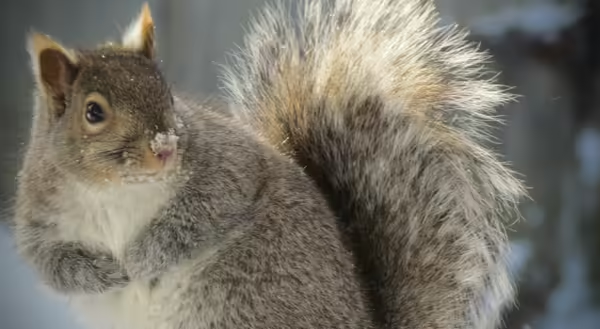
As part of nature ourselves, humans feel a connection with the natural world-a feeling I don’t have to explain to any of you. This connection has caused us to seek out nature or integrate more natural elements into our landscapes. Prior to the Landscape Parks Movement in the 1870’s, our urban landscapes held little to no trees, and parks were few and far between. But the urban residents still craved that natural element, so cities such as Philadelphia, Boston, and New Haven introduced the eastern grey squirrel (Sciurus carolinensis) as part of their communities. They were trapped from nearby old growth hardwood forests and transported to a new urban home (i.e. small trees with nest boxes). The cities utilized money from their budgets to provide regular food for the squirrels throughout the winter and friendly city residents fed them whenever they pleased.
Unfortunately, these initial experiments failed without human intervention. After cities stop providing food and removed the nest boxes, come winter, all the squirrels had died off. But why? We don’t have urban squirrel feeding programs in 2020. And some of us may feed them, but if they were just human supported, they wouldn’t be so prolific in our urban landscapes.
The answer to that lies in squirrel ecology and how our urban landscapes shifted in the 1870s. Similar to many squirrels in Illinois, the eastern grey squirrel eats the buds of maples and elms, nuts and berries; the bread and butter of the squirrel diet, however, is the masts of trees including hickory nuts, beechnuts, and of course acorns. These hard-covered seeds are durable enough to sustain their nutritional value after being cached away, therefore essential to winter survival. These hardwood trees also provide sturdy branches for dreys and cavities for more protective shelters. Additionally, the eastern grey squirrel, like many Illinois tree squirrels are fairly prolific in their reproduction, having 2 litters of approximately 2-4 young annually.
In the 1800s, these mast-bearing trees were only common places in forested areas. Enter Fredrick Lawn Olmstead: landscape architect with an affinity for bringing nature to urban landscapes. This view and the 1870s Landscape Parks Movement changed the way we designed neighborhoods to incorporate natural elements and prioritize parks. An essential natural element was the tree, particularly oaks- the perfect pairing with the squirrel. Now our urban landscapes had exactly what the squirrels needed.
Paired with the right food, shelter, and reproductive success; human infrastructure provided the eastern grey squirrel with the extra boost it needed to become the commonplace urban creature we know today. Our buildings and homes provided extra protection from predators, our food waste provided enough to make them extra plump, and our telephone and electric powerlines provided a squirrel highway free of predators.
As we look out our windows to find a particularly rotund squirrel hopping around our yards or gardens, we remember that these creatures are an excellent example of the craving and connection humans have with nature. As we brought these squirrels to our landscapes to fulfill this need, these creatures found fulfillment in our human habits and infrastructure.
Check out this Article from the Journal of American History to read the in-depth history on the Urbanization of Squirrels: The Urbanization of the Eastern Gray Squirrel in the United States
Want to get notified when new Naturalist News posts are available? SIGN UP HERE!
Abigail Garofalo is an Energy and Environmental Stewardship Educator for Cook County. She manages the Cook County Master Naturalist program and the Conservation@Home program for University of Illinois Extension. She has a BS in Natural Resources and Environmental Sciences and MS in Agricultural Leadership Education both from University of Illinois Urbana Champaign. Her background in is environmental outreach and interpretation and works to create a culture of environmentalism through community buidling.
Naturalist News is a blog by University of Illinois Extension Master Naturalist staff and volunteers who bring you stories highlighting the individuals, places, wildlife and plants that make this state amazing. Join us each week to learn something new, be inspired and become connected to your own community by recognizing the amazing ways we are all intertwined.